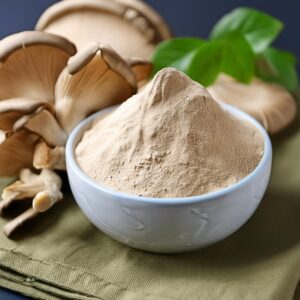

Introduction
Chitosan, a biopolymer derived from chitin found in crustaceans and insects, has emerged as a promising additive in dairy farming due to its antimicrobial, antioxidant, and anti-inflammatory properties[1][2]. This presentation explores its effects on milk production, cow health, and broader applications in the dairy industry.
Key Benefits of Chitosan in Dairy Farming
- Improved Milk Yield and Composition
- Supplementation with chitosan increases milk yield, protein, and lactose levels but does not affect total milk solids[1].
- Enhanced rumen fermentation improves nutrient digestion and metabolism, leading to higher energy-corrected milk output[1].
- Antioxidant Effects
- Chitosan boosts antioxidant enzyme activities (e.g., superoxide dismutase) while reducing oxidative stress markers like malondialdehyde (MDA) and reactive oxygen species (ROS)[1].
- Higher doses (1500–2000 mg/kg DM) are more effective for antioxidant benefits[1].
- Feed Efficiency
- Chitosan enhances nutrient utilization efficiency, increasing long-chain fatty acid concentrations without compromising intake or digestibility[2].
Mechanisms of Action
- Rumen Fermentation: Chitosan promotes propionate production and microbial protein synthesis, improving energy availability for lactation[1][2].
- Antimicrobial Traits: It inhibits biohydrogenation and supports unsaturated fatty acid concentration[2].
- Anti-inflammatory Properties: Suppresses nuclear factor-κB signaling pathways, reducing inflammatory responses[1].
Challenges
- Interaction with soybean oil can negatively affect performance, highlighting the importance of diet composition when using chitosan[2].
Broader Applications in Dairy Industry
- Smart Packaging
- Chitosan-based materials extend shelf life and enhance food safety by detecting contaminants like bacteria and toxins[3].
- Biosensors
- Advanced chitosan biosensors enable precise detection of milk contaminants such as antibiotics and heavy metals, ensuring quality control[3].
- Drug Delivery Platforms
- Innovative chitosan nanoparticles are being developed for safe delivery of bioactive ingredients in dairy-related applications[3].
Future Directions
Emerging technologies like artificial intelligence and gene editing may optimize chitosan applications further, addressing energy challenges in dairy farming while ensuring sustainability[3].
Conclusion
Chitosan represents a multifunctional solution for enhancing milk production, cow health, and industry innovation. Continued research will unlock its full potential across various dairy applications.
This presentation is designed to inform stakeholders about the transformative role of chitosan in modern dairy farming practices.
⁂
Main Benefits of Using Chitosan in Dairy Cow Diets
- Improved Milk Production
- Antioxidant Properties
- Anti-inflammatory Effects
- Feed Efficiency
- Biodegradable and Non-toxic
⁂
What is the optimal dosage of chitosan for dairy cows
The optimal dosage of chitosan for dairy cows is 1500–2000 mg/kg of dry matter (DM) intake. This range has been shown to enhance milk production, improve antioxidant status, and reduce inflammation effectively. Higher doses within this range yield better results in terms of antioxidant enzyme activity and suppression of oxidative stress markers[7].
⁂
Long-Term Effects of Chitosan Supplementation on Dairy Cow Health
- Enhanced Antioxidant Status
- Chitosan improves the activity of antioxidant enzymes (e.g., superoxide dismutase, catalase) and reduces oxidative stress markers like malondialdehyde (MDA) and reactive oxygen species (ROS). This helps mitigate the long-term effects of oxidative stress, a common issue in high-producing dairy cows[8].
- Reduced Inflammation
- Long-term supplementation downregulates inflammatory pathways (e.g., NF-κB signaling), reducing the production of pro-inflammatory mediators like interleukin-1 (IL-1) and nitric oxide. This alleviates chronic inflammation, improving overall health and immune function[8].
- Improved Immune Function
- Chitosan enhances the proportion of beneficial lymphocyte subpopulations (e.g., CD4+ cells) and increases immunoglobulin levels (IgM, IgA, IgG). It also lowers somatic cell counts (SCC) in milk, indicating better immune response and reduced infection risks[8].
- Better Nutrient Utilization
- Sustainability Benefits
These benefits collectively improve long-term productivity, health, and resilience in dairy cows.
 ⁂
⁂
Effects of Chitosan Supplementation on the Health and Well-Being of Dairy Cows and Other Farm Animals
- Improved Antioxidant Status
- Reduced Inflammation
- It suppresses inflammatory pathways (e.g., NF-κB signaling), reducing pro-inflammatory mediators such as interleukin-1 (IL-1) and nitric oxide. This alleviates chronic inflammation and promotes better immune function[12].
- Enhanced Immune Response
- Chitosan increases the proportion of beneficial lymphocytes (e.g., CD4+ cells) and immunoglobulins (IgM, IgA, IgG), while lowering somatic cell counts in milk, indicating reduced infection risks[12].
- Better Nutrient Utilization
- Sustainability Benefits
- The antimicrobial properties of chitosan reduce reliance on antibiotics, supporting sustainable farming practices[15].
Overall, chitosan supplementation improves milk performance, reduces disease risks, and promotes long-term health in dairy cows.
⁂
Differences in Response to Chitosan Supplementation Between High-Producing and Low-Producing Dairy Cows
- Oxidative Stress and Antioxidant Benefits
- High-producing cows experience greater oxidative stress due to their higher metabolic demands, making them more responsive to chitosan’s antioxidant properties. Chitosan supplementation significantly reduces oxidative stress markers like malondialdehyde (MDA) and reactive oxygen species (ROS), benefiting high-producing cows more noticeably[16][17].
- Inflammatory Response
- High-producing cows are more prone to inflammation due to their increased energy and nutrient requirements. Chitosan’s anti-inflammatory effects, such as suppression of NF-κB signaling and reduction of pro-inflammatory mediators, are particularly beneficial for these cows, improving immune function and reducing somatic cell count (SCC) in milk[16][17].
- Nutrient Utilization
- High-producing cows require efficient nutrient utilization to sustain milk production. Chitosan enhances rumen fermentation by increasing propionate production and improving crude protein digestibility, which supports the higher energy demands of these cows. Low-producing cows may show less dramatic improvements in nutrient efficiency[16][18].
- Milk Yield and Composition
In summary, while both high- and low-producing dairy cows benefit from chitosan supplementation, the effects are more significant in high-producing cows due to their greater susceptibility to oxidative stress, inflammation, and nutrient demands.
⁂
How does chitosan supplementation impact the milk composition of high-producing dairy cows
Chitosan supplementation positively impacts the milk composition of high-producing dairy cows in several ways:
- Increased Milk Protein and Lactose
- Improved Energy-Corrected Milk Yield
- No Effect on Total Solids
- While protein and lactose levels increase, total milk solids remain unaffected, indicating targeted improvements in specific components[19].
- Enhanced Fatty Acid Profile
- Chitosan increases unsaturated fatty acid concentrations in milk, improving its nutritional quality[21].
These benefits make chitosan a valuable supplement for optimizing milk composition in high-producing dairy cows.
⁂
How fast can quaternary chitosan cream, applied daily, heal mastitis?
The healing time for mastitis using quaternary chitosan cream, applied daily, depends on the severity of the infection. Studies indicate that chitosan has strong antimicrobial and wound-healing properties, particularly against biofilm-forming pathogens like Staphylococcus species, which are common in mastitis cases. When combined with antibiotics or used alone, chitosan can significantly reduce bacterial loads and inflammation.
While specific data on quaternary chitosan cream for mastitis is limited, general findings suggest that noticeable improvements in infection and inflammation can occur within 1–2 weeks for moderate cases. Chronic or severe mastitis may take longer, potentially up to 3–4 weeks, depending on the cow’s immune response and the pathogen involved[22][23].
⁂
How effective is chitosan cream compared to traditional antibiotics for treating mastitis
Chitosan cream is highly effective in treating mastitis, particularly against antibiotic-resistant pathogens and biofilm-forming bacteria like Staphylococcus species. Here’s a comparison between chitosan cream and traditional antibiotics:
Effectiveness
- Chitosan Cream:
- Exhibits strong antimicrobial activity, targeting bacterial cell walls and biofilms, which are often resistant to antibiotics[24][25].
- Reduces the minimum bactericidal concentration needed when combined with antibiotics, enhancing overall treatment efficacy[24][25].
- Prevents antibiotic resistance due to its unique mechanism of action[26].
- Traditional Antibiotics:
Advantages of Chitosan Cream
- Broad-spectrum antimicrobial activity without promoting resistance[26].
- Effective against chronic mastitis cases where biofilms protect bacteria from antibiotics[24][25].
- Biodegradable and safe for localized therapy[27].
Limitations
- Chitosan formulations may require further optimization for large-scale commercial use and cost reduction[26].
In summary, chitosan cream is a promising alternative or complement to antibiotics for mastitis treatment, particularly in cases involving resistant or biofilm-forming pathogens.
⁂
Are there any specific conditions under which chitosan cream is more effective than antibiotics
Chitosan cream is more effective than antibiotics under specific conditions, including:
- Biofilm-Forming Infections
- Antibiotic-Resistant Pathogens
- Localized Therapy
- Chitosan cream ensures high drug concentration at the infection site, reducing systemic exposure and minimizing side effects compared to systemic antibiotics[29].
- Combination Therapy
- Chitosan enhances the efficacy of antibiotics when used together, reducing the required dosage and limiting resistance development[31].
These conditions highlight chitosan’s advantages in treating complex or resistant mastitis cases.
⁂
Are there specific types of bacterial infections where chitosan cream outperforms antibiotics
Chitosan cream outperforms antibiotics in treating bacterial infections under specific conditions:
- Biofilm-Forming Bacteria
- Chitosan effectively disrupts biofilms, a protective matrix formed by bacteria such as Staphylococcus aureus and Pseudomonas aeruginosa, which often render antibiotics less effective. Its ability to permeabilize cell membranes and destabilize biofilms gives it an advantage over traditional antibiotics[32][33].
- Antibiotic-Resistant Pathogens
- Localized Therapy
- Chitosan cream achieves high concentrations at the infection site, reducing systemic exposure and side effects while maintaining efficacy against pathogens like Pseudomonas fluorescens and aureus[33].
These advantages make chitosan cream particularly effective for infections involving biofilms or resistance mechanisms.
⁂
- https://www.dairyglobal.net/health-and-nutrition/nutrition/chitosan-improves-milk-yield-in-holstein-cows/
- https://www.feednavigator.com/Article/2017/07/15/Supplementing-dairy-feed-with-chitosan-supports-milk-production-feed-efficiency/
- https://pubmed.ncbi.nlm.nih.gov/39740715/
- https://www.dairyglobal.net/health-and-nutrition/nutrition/chitosan-improves-milk-yield-in-holstein-cows/
- https://pmc.ncbi.nlm.nih.gov/articles/PMC10525946/
- https://www.feednavigator.com/Article/2017/07/15/Supplementing-dairy-feed-with-chitosan-supports-milk-production-feed-efficiency/
- https://www.dairyglobal.net/health-and-nutrition/nutrition/chitosan-improves-milk-yield-in-holstein-cows/
- https://www.dairyglobal.net/health-and-nutrition/nutrition/chitosan-improves-milk-yield-in-holstein-cows/
- https://pmc.ncbi.nlm.nih.gov/articles/PMC10525946/
- https://onlinelibrary.wiley.com/doi/10.1111/jpn.14057
- https://www.feednavigator.com/Article/2017/07/15/Supplementing-dairy-feed-with-chitosan-supports-milk-production-feed-efficiency/
- https://www.dairyglobal.net/health-and-nutrition/nutrition/chitosan-improves-milk-yield-in-holstein-cows/
- https://pmc.ncbi.nlm.nih.gov/articles/PMC8001170/
- https://onlinelibrary.wiley.com/doi/10.1111/jpn.14057
- https://www.feednavigator.com/Article/2018/11/07/Alternative-antimicrobial-chitosan-may-boost-dairy-cow-feed-efficiency/
- https://www.dairyglobal.net/health-and-nutrition/nutrition/chitosan-improves-milk-yield-in-holstein-cows/
- https://www.mdpi.com/2311-5637/8/10/549
- https://pmc.ncbi.nlm.nih.gov/articles/PMC10525946/
- https://www.dairyglobal.net/health-and-nutrition/nutrition/chitosan-improves-milk-yield-in-holstein-cows/
- https://pmc.ncbi.nlm.nih.gov/articles/PMC10525946/
- https://www.feednavigator.com/Article/2018/11/07/Alternative-antimicrobial-chitosan-may-boost-dairy-cow-feed-efficiency/
- https://www.frontiersin.org/articles/10.3389/fmicb.2023.1167693/full
- https://pmc.ncbi.nlm.nih.gov/articles/PMC8704789/
- https://www.frontiersin.org/journals/microbiology/articles/10.3389/fmicb.2023.1167693/full
- https://pubmed.ncbi.nlm.nih.gov/37152721/
- https://www.agproud.com/articles/18972-chitosan-microparticles-a-potential-alternative-treatment-to-antibiotics
- https://pmc.ncbi.nlm.nih.gov/articles/PMC8704789/
- https://pmc.ncbi.nlm.nih.gov/articles/PMC3188448/
- https://pmc.ncbi.nlm.nih.gov/articles/PMC8704789/
- https://onlinelibrary.wiley.com/doi/full/10.1002/mame.202400018
- https://academic.oup.com/milmed/article/185/Supplement_1/637/5740707
- https://pmc.ncbi.nlm.nih.gov/articles/PMC3188448/
- https://pmc.ncbi.nlm.nih.gov/articles/PMC8704789/
- https://www.mdpi.com/2073-4360/13/6/904
